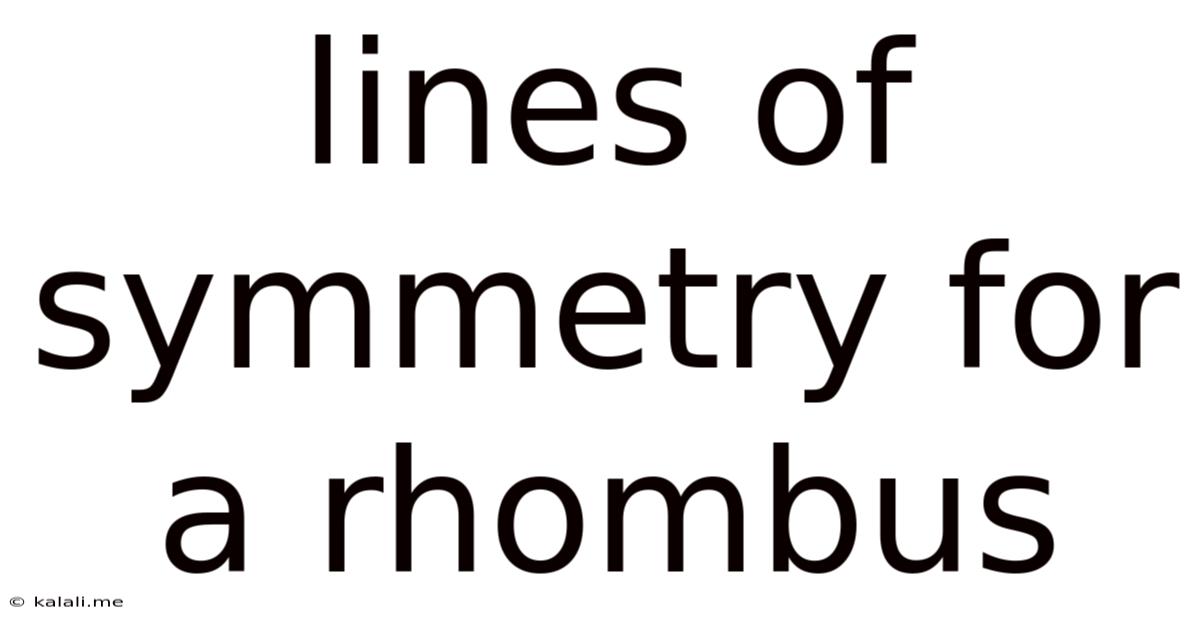Lines Of Symmetry For A Rhombus
Kalali
Jun 13, 2025 · 2 min read

Table of Contents
Lines of Symmetry for a Rhombus: A Comprehensive Guide
A rhombus, a quadrilateral with all sides equal in length, possesses a fascinating geometrical property: lines of symmetry. Understanding these lines is crucial for various applications in geometry, art, and design. This article will delve into the lines of symmetry of a rhombus, explaining their properties and how to identify them. We'll also explore the relationship between lines of symmetry and the diagonals of a rhombus. This guide aims to provide a clear and comprehensive understanding of this topic, suitable for both beginners and those seeking a deeper understanding of geometrical concepts.
What is a Line of Symmetry?
Before exploring the lines of symmetry in a rhombus, let's define the concept. A line of symmetry divides a shape into two identical halves that are mirror images of each other. If you were to fold the shape along the line of symmetry, both halves would perfectly overlap.
Identifying Lines of Symmetry in a Rhombus
Unlike a square, which has four lines of symmetry (two diagonals and two lines bisecting opposite sides), a rhombus typically has only two lines of symmetry. These lines are:
-
The two diagonals: A rhombus's diagonals are unique. They bisect each other at right angles, and importantly, each diagonal acts as a line of symmetry. Folding the rhombus along either diagonal will perfectly overlap the two halves.
-
No other lines of symmetry exist: Unlike squares or rectangles, a rhombus does not have lines of symmetry that bisect its sides. This is because, while all sides are equal in length, the angles are not necessarily right angles. This difference differentiates the rhombus from a square, impacting its symmetry properties.
Special Cases: The Square
It's important to note a crucial exception. A square is a special case of a rhombus where all angles are right angles. In this instance, the square exhibits four lines of symmetry: the two diagonals, and the two lines connecting the midpoints of opposite sides.
Why are Lines of Symmetry Important?
Understanding the lines of symmetry of a rhombus has practical implications in various fields:
-
Geometric constructions: Identifying lines of symmetry is essential for accurately constructing and manipulating rhombuses in geometrical problems.
-
Art and design: Artists and designers often use rhombuses and their lines of symmetry to create visually appealing and balanced patterns and designs. Understanding the symmetry enhances creative possibilities.
-
Tessellations: The symmetrical nature of rhombuses allows for the creation of interesting and repeating patterns in tessellations.
Conclusion:
In conclusion, a rhombus typically possesses two lines of symmetry, both corresponding to its diagonals. This understanding is fundamental to grasping the geometric properties of this shape and its applications in diverse fields. Remember the special case of the square, which inherits the properties of a rhombus while gaining additional lines of symmetry due to its right angles. By understanding these principles, you gain a deeper appreciation for the geometric beauty and utility of the rhombus.
Latest Posts
Latest Posts
-
How Many Cubic Feet Are In A 5 Gallon Bucket
Jul 01, 2025
-
1 Lb Of Pasta Is How Many Ounces
Jul 01, 2025
-
How Many Ounces In A Pint Of Blueberries
Jul 01, 2025
-
When Derivatively Classifying Information Where Can You Find A Listing
Jul 01, 2025
-
How Many Hours Is 9am To 1pm
Jul 01, 2025
Related Post
Thank you for visiting our website which covers about Lines Of Symmetry For A Rhombus . We hope the information provided has been useful to you. Feel free to contact us if you have any questions or need further assistance. See you next time and don't miss to bookmark.